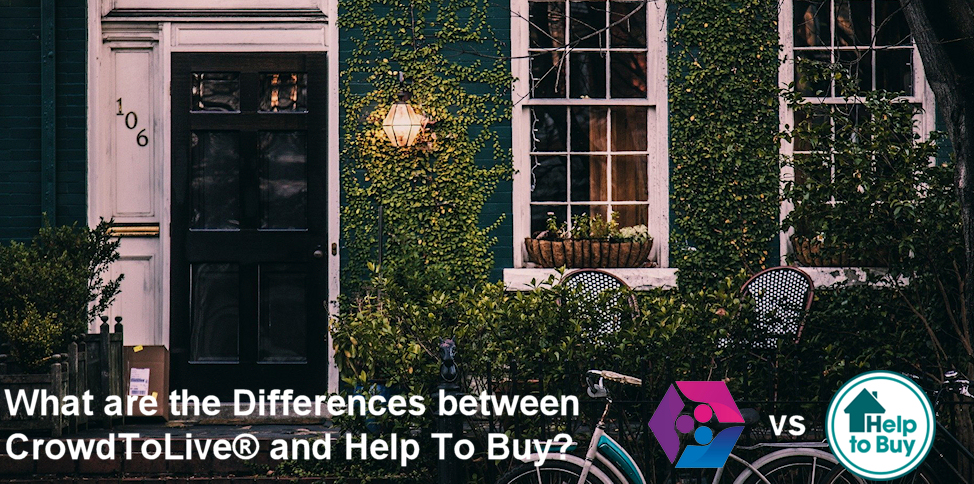Differences between CrowdToLive and Shared Ownership
It isn’t easy to get onto the property ladder for the first time. Across the UK, house prices are rising much faster than wages, meaning that houses are becoming less and less affordable.
Many individuals are having to wait until later in life to buy their first home. For this reason, the average age to buy a first home is now into the mid-30s. Those stuck in the rental trap often struggle to save enough of a deposit to make their mortgage affordable, especially since the percentage of salary spent on mortgage payments is increasing year-on-year. With all of these factors considered, there’s no wonder that more and more people are going in search of schemes that will help them to get their feet firmly onto the property ladder. Many of these people look to the Government’s Shared Ownership scheme, not realising that there is an alternative: CrowdToLive®.
CrowdToLive® is a new and innovative scheme that matches Champions, or prospective home buyers, with investors. For as little as 5% of the purchase price, you are able to purchase your dream home, mortgage-free. Rather than applying for a loan for the remainder of the property price, our investor base will buy the property with you. You will then pay rent on the portion of the house that you don’t own.
But what are the real differences between the Shared Ownership scheme and the CrowdToLive® offering?

Read on to find out more about the critical differences between CrowdToLive® and Shared Ownership.
Minimum share
The first key difference between the Shared Ownership scheme and CrowdToLive® is the minimum share required. The Shared Ownership scheme typically requires the buyer to purchase at least a 25% share of the property. This high level of initial investment makes it unaffordable for many, with many homebuyers still requiring a mortgage.
CrowdToLive® on the other hand only asks the buyer to purchase a minimum of 5% of the property. This reduced initial outlay makes the CrowdToLive® offering access to a much wider range of prospective homebuyers.
Debt or no debt?
As the Shared Ownership scheme requires an initial purchase of at least 25% of the property, most buyers still need to take out a mortgage. This leaves the buyer paying monthly mortgage payments on the share of the property that they own, along with rental payments on the remainder of the property.
As well as going through the processes required for Shared Ownership, the buyer also needs to apply for and be approved for a mortgage. This relies on a good credit rating and can often pose a challenge for the self-employed, expatriates and senior citizens.
CrowdToLive® offers a debt-free solution to property ownership. You can become a homeowner with as little as 5% of the property value. Through the CrowdToLive® platform, you are matched with investors who purchase the remaining share of the property, allowing you to live free from both mortgage and debt.
Flexibility
The Shared Ownership scheme allows the homebuyer to purchase between 25% and 75% of their home. There are no options outside of this range, so you are forced to choose a share within this bracket.
In contrast, CrowdToLive® allows you to choose the precise share of the property that they wish to purchase, allowing for ultimate flexibility. Whether you want to purchase a 5% share in your home or 80% of it, we will match you with the right investors to allow you to purchase your dream property.

Type of property
Possibly the biggest difference between the Shared Ownership scheme and CrowdToLive® is the type of property that you can buy. The Shared Ownership scheme allows the buyer to choose from a selection of houses that are owned, for example, by housing associations. The range of houses on offer is generally limited, meaning that the buyer is often forced to compromise on their requirements.
CrowdToLive® allows you to choose any house on the market. This means that you can use the CrowdToLive® platform to purchase your dream house. Whether you picture yourself living in a city centre apartment or a Victorian townhouse, CrowdToLive® can help you to achieve your dream. Our service isn’t limited to off-plan or housing association stock – you can take your pick of properties listed by private sellers marketing their property on Rightmove or Zoopla for example.
Most homeownership schemes, including Shared Ownership, offer only a leasehold option. At CrowdToLive®, we offer both leasehold and freehold properties.
Eligibility
A final difference between the Shared Ownership scheme and CrowdToLive is the eligibility criteria. The Shared Ownership scheme has strict eligibility criteria including a household income below £80,000 (or £90,000 in London), as well as being a first-time buyer or an existing shared owner.
With CrowdToLive®, there is no cap on income. Providing you’ve never defaulted on payments, been declared bankrupt or received a CCJ, the CrowdToLive® platform is open to you, whether you’re a first-time buyer or a seventh-time buyer! This makes the CrowdToLive® platform highly accessible, enabling prospective buyers to take the first step in purchasing their dream home.
Suitability
CrowdToLive® is available to people of all walks of life but it’s particularly suitable for people who have difficulty getting approved for a standard mortgage such as:
- First Time Buyers
- NHS/Key Workers
- Muslims
- Self-Employed
- Expats
Support
Whatever your level of knowledge when it comes to property crowdfunding, CrowdToLive® is here to support you. We can guide you through the process, explaining your options and answering any questions that you have along the way.
If you’re ready to take the first step towards owning your dream home, apply to become to CrowdToLive Champion today. For any questions, you can contact us here. We’re here to help!


